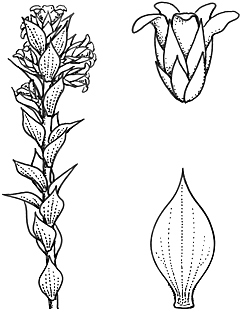Epacris breviflora Stapf APNI* 
Description: Erect shrub 50–100 cm, sometimes to 200 cm high; stems with inconspicuous leaf scars; branchlets tomentose.
Leaves erect to spreading, ovate, 4–7.5 mm long, 1.6–3.6 mm wide, apex acute, base cuneate, margins ± entire; lamina ± thick, flat to concave, discolorous; petiole c. 1 mm long.
Flowers conspicuous, erect, 5–6.5 mm diam., clustered in upper axils to form heads, ± sessile, white; bracts ± acute, ± keeled. Sepals 2.9–4 mm long. Corolla 1.5–1.9 mm long; lobes 2.3–3.3 mm long. Anthers obvious in throat or half-exserted.
Capsule c. 1.8 mm long.
Flowering: Flowers and fruits throughout year, mostly in summer.
Distribution and occurrence: Grows in swamps and damp places at 350-1500 m alt., from the main Dividing Range west to near Holbrook.
NSW subdivisions: NC, NT, CT, ST, SWS
Other Australian states: Qld Vic.
Text by J. M. Powell, except for groups with contributors listed
Taxon concept: Flora of NSW 3 (1992)
ECOLOGY
Life History
Flowers White, November--March.
Fruit/seed Capsule 1.8 mm long, mature at any time of year but mostly summer.
Habitat
Habitat Swamps and damp places.
Altitude 1000--1200 m
Annual rainfall 1000--1100 mm
Typical local abundance Rare.
Vegetation Swamps, creekbanks, closed heath e.g. with Leptospermum; open-forest e.g. with Eucalyptus fastigata, E. dalrympleana, E. viminalis.
Substrate Alluvial soil.
APNI* Provides a link to the Australian Plant Name Index (hosted by the Australian National Botanic Gardens) for comprehensive bibliographic data
***The AVH map option provides a detailed interactive Australia wide distribution map drawn from collections held by all major Australian herbaria participating in the Australian Virtual Herbarium project.
|


